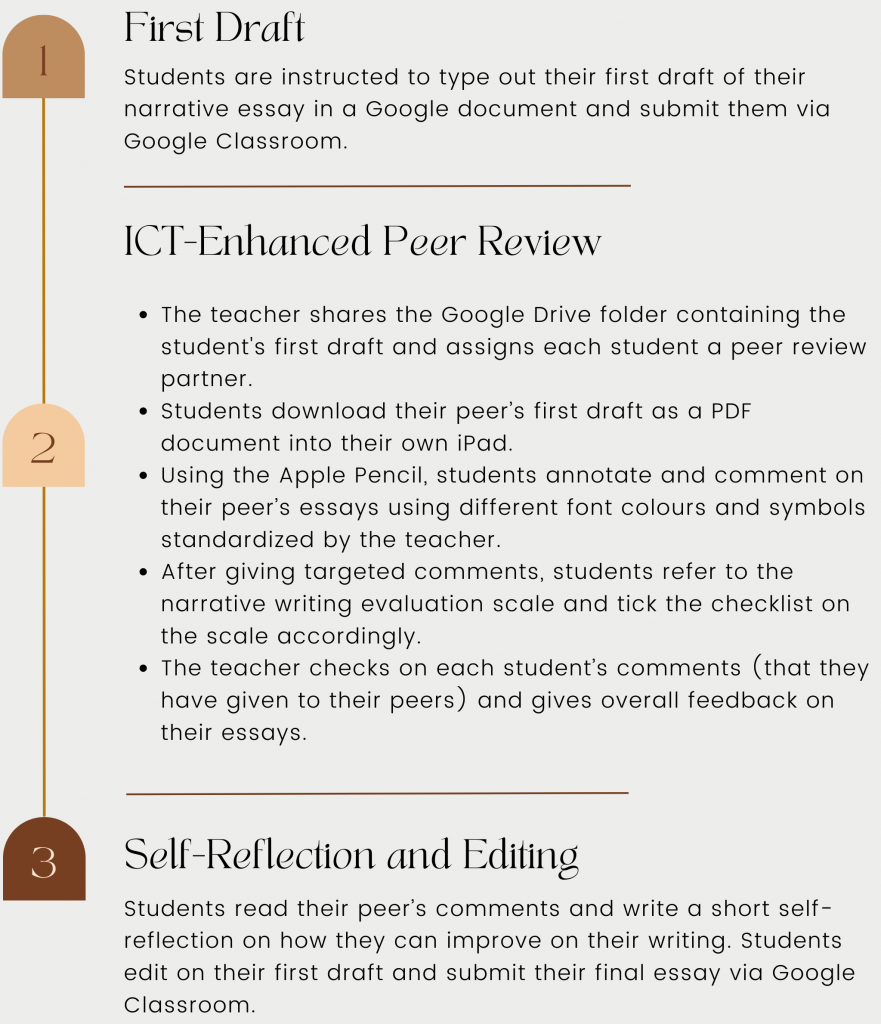Using ICT-Enhanced Peer Review Process to Improve Students’ Narrative Writing
Contributed by Ms Neo Jia Hui, from Raffles Girls’ School, for SingTeach Virtual Staff Lounge
The implementation of the new Chinese syllabus in 2021 places a strong emphasis on self-directed learning. With the introduction of iPads as student personal learning devices at Raffles Girls’ School, the school’s Year 1 Higher Chinese Language team has been incorporating the use of online platforms and iPads in the teaching of process writing and peer review to improve students’ narrative writing skills.

2022 Y1HCL team (from left to right): Ms Neo Jia Hui, Mr Chua Han Hui, Mdm Lee Szer Yuen and Ms Lin Yao.
The ICT-Enhanced Peer Review Process
The narrative writing process, as taught to the Year 1 Higher Chinese Language (Y1HCL) cohort, consists of 3 main steps:

Reflections of Teachers
In 2022, the Y1HCL team of teachers embarked on an action research on the effectiveness of using technology in peer review. Based on the feedback from teachers and students, the team reflected on the peer review process and would like to share some takeaways from using ICT tools in peer review.
Simplifying the Process While Giving Students Choices
The ICT-enhanced peer review process posed challenges for both teachers and students. Teachers gave feedback that the peer review process can be simplified, as some students found it cumbersome and confusing to convert Google Documents into PDF before they can use their Apple Pencil to annotate. Teachers then have to spend more time in addressing this problem. Some students also share that they prefer to be given a choice to either type or write out their first draft and final submission as some wanted more practice in handwriting an entire essay.
Based on the feedback, we have learnt that to leverage technology in promoting greater efficiency as well as catering to the needs of different students, we should simplify the process of writing essays and peer review by using only one to two ICT tools or platforms. For example, for students who prefer to type, they can type their first draft and provide peer review via Google Document. For students who prefer to write by hand, they can choose to handwrite their first draft, scan it as a PDF document and provide peer review using Apple Pencil. This will minimize the need for students to toggle with different platforms and convert each document.
Making Use of ICT Tools to Visualize Content
Many students gave positive feedback on the use of Apple Pencil during the peer review process. Using the Apple Pencil to annotate allows them to use different font colours and symbols to visualize the different content and descriptions, strengths and areas for improvement clearly. To better facilitate this process, clear and standardized instructions should be given, such as using green to underline sentences with grammatical errors, and/or using blue to highlight character thoughts and feelings, etc.
Giving Targeted and Constructive Feedback
To better help students in giving targeted comments, good feedback samples must be provided. Prior to the peer review, teachers can give students more time to practice on giving feedback through platforms like Student Learning Space (SLS). This allows students to learn and put their skills into practice at their own time and pace before the actual peer review. More class time should also be given to teachers to better guide the peer review process.
Conclusion
This action research serves as a great opportunity for the Y1HCL teachers to reflect on our current peer review process and share our takeaways. We will continue to explore and improve on our current processes, and use ICT tools as an enabler to make the peer review process more self-directed and efficient for students.






